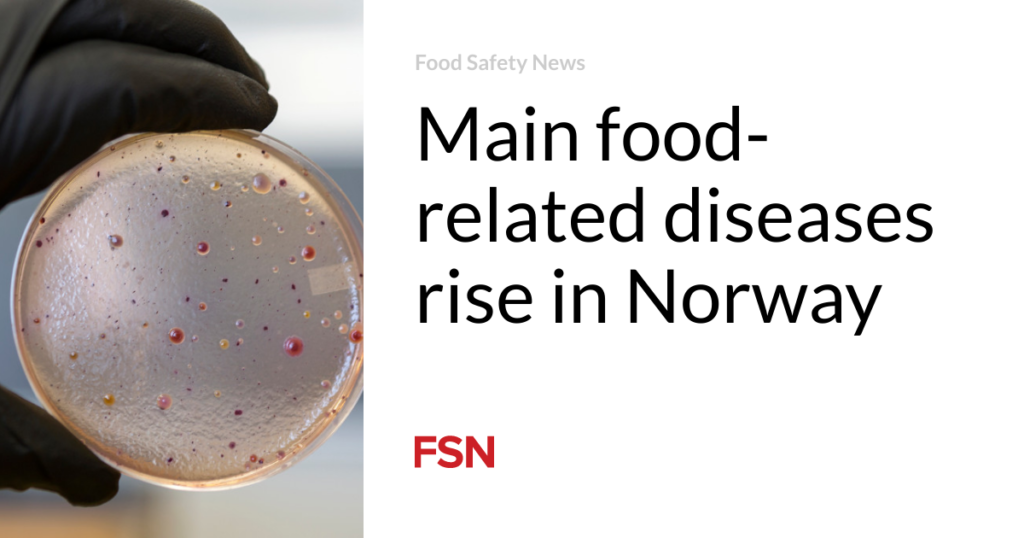Norway saw a record high in E. coli infections in 2023, but other pathogens are returning to pre-coronavirus pandemic levels.
Data published by the Norwegian Public Health Institute (FHI) showed that the number of Campylobacter, Salmonella, E. coli and Listeria infections increased compared to the previous year, while the number of Yersinia infections decreased.
A total of 3,034 cases of campylobacteriosis were reported. Half were infected in Norway and the other half were infected abroad where the place of infection was known. This information was not available for nearly 600 cases. The most common travel destinations for infected people were Spain, including the Canary Islands and Mallorca, Turkey and Thailand.
Campylobacter trails behind in most cases, but the amount is still lower than before the pandemic. For the most part, details of the species found were not released, but Campylobacter jejuni caused more than 1,100 cases. Men were slightly more affected than women, and 907 were hospitalized.
In a previous article, we detailed 25 outbreaks caused by contaminated food in 2023 that sickened 518 people.
Record high levels of E. coli
There were 663 cases of E. coli infection, three-quarters of which were contracted in Norway and one-quarter abroad. Data is unavailable for 158 cases. Most infections were in people aged 0-9 years, followed by 20-29 years and 50-59 years.
The number of reported cases of E. coli infections is at an all-time high. It is unclear whether this increase is due to improved diagnosis, more people being tested, or more people becoming ill.
Among the reported cases, E. coli O26 and O157 were the most common serogroups. A total of 187 people were hospitalized, 30 of whom were between 1 and 9 years old. Seventeen people developed hemolytic uremic syndrome (HUS), 15 of whom were in the youngest age group. Nine cases were part of an E. coli O26 outbreak, while the others were infected with O26, O157, and O128ab.
For Salmonella, 757 cases were reported in 2023, of which 37% were acquired in Norway and 63% were acquired abroad. This data is missing for cases with more than 100 cases. The top travel-related infections were linked to Spain, the Canary Islands, Mallorca, Turkey and Thailand.
The majority of the cases were reported in August, September and October. Most were in the 20-29, 50-59 and 60-69 age groups. About 250 people required hospitalization. The number of cases was higher than the 712 cases in 2022 but lower than the 1,094 cases in 2019, before the pandemic.
Salmonella Enteritidis was the most common with 240 cases, followed by Salmonella Typhi with 77 cases.
Listeria and other pathogens
A total of 39 cases of listeriosis were recorded, the majority of them in Norway. The number of cases is up compared to 31 in 2022, the highest since 2014. The trend is seen in other parts of Europe and may be due to a growing elderly population that is more vulnerable to infection.
All hospitalized patients were primarily in the age groups of 70 to 79, 80 to 89, and 60 to 69. Sixteen were women and 23 were men.
539 cases of cryptosporidiosis were reported, two-thirds of which were acquired in Norway and one-third abroad. The number of travel-associated cases was the highest on record. Many cases were reported in August and September. Nearly 100 people were hospitalized. Most of the cases were in the age groups 30-39, 20-29 and 0-9.
Officials said they have seen a steady increase in cryptosporidiosis cases in recent years due to improved diagnostic techniques, but that the actual number of infections is probably also increasing.
In 2023, there was one case of brucellosis overseas, 29 cases of hepatitis A, 21 of whom were hospitalized, and 85 cases of Yersinia enterocolitica, 30 of whom were hospitalized.
(Click here to sign up for a free subscription to Food Safety News.)



